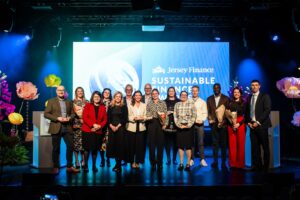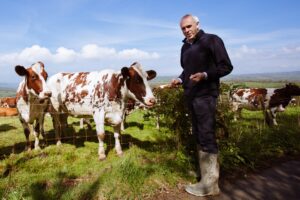
FORAGING WITH Kazz Padidar.
This is an expansion of an article that appeared in the November 2013 issue of RURAL magazine
WHEN the Day of the Triffids dawns, when the Kraken Wakes, when oil ceases to flow, thus bringing to a halt both the transport system and also emptying the supermarket shelves of purchasable food, when civilisation As We Know It ends … in short, whatever your favourite apocalypse, then Kazz Padidar will likely be your man.
Put him in a field, and he’ll eat the plants, doubtless to the annoyance of the cows and the rabbits. If he invites you to dinner, the menu might well consist of roasted burdock root and wild carrot, with strips of lightly fried jew’s ear (a wild mushroom) served on a bed of spring beauty ?? and chickweed, with some wild sorrel leaves arranged around the side.
Foraging has always been his passion, and it is something that he still does regularly, teaching the public about local edible plants in the course of what he calls ‘Wild Walks’, mainly from Kempt Tower in St Ouen inland and uphill to Mont Grantez Dolmen.
He was born and brought up in Jersey, and his parentage is half Iranian and half Breton. He spent a lot of time on his Breton grandmother’s farm at the bottom of Mont Ubé woods in St Clement. His grandmother, who had lived in Jersey during the Occupation, never learnt to speak a word of English. During the war she foraged for food for the most practical of reasons and so, just like other Islanders in those harsh times, went back to the land and ate plants that had once been recognised as useful but which people had since forgotten how to use.
‘She was definitely the inspiration for me,’ he recalled. ‘Of course the Occupation was a terribly negative thing, but there was at least one positive aspect: people started remembering how to connect with their local environment.’
As a boy, for much of his free time when not at De La Salle he was on the farm, helping with the livestock – the cows and the chickens – growing the vegetables, which were not only sold but also supplied all the domestic needs of the household, and playing in the woods. He and his brothers would also walk down to the nearby coast at Green Island, and go low-water fishing and forage in rock pools.
‘I think these childhood experiences were the foundations of my present interest and awareness of the natural environment, and of my subsequent adult career. In particular, the natural creation gave me the realisation that it can provide with us nourishment as well as offering aesthetic delight and beauty. In practical terms, it provides us with things that are edible and sustainable – so that you don’t have to depend on supermarkets!’
As he grew up he became a keen sports player, and at the age of 16 lived in Canada for a while. There, in the Northern Territories, he first encountered a totally natural and unspoilt wilderness: he climbed mountains, he went kayaking, he trekked…
‘It just blew my mind,’ he said, ‘and the way it made me feel was that I realised that I wanted to help other people to experience it as well.’
Eventually he went to university and did a degree in sports management. He became an outdoor adventure training instructor, teaching rock climbing and kayaking, His work took him to the Val d’Aosta in the Italian Alps, where he first began to teach foraging skills for wild food.
His students included parties of young people from inner-city Britain, aged around 16, who had been in and out of Borstal, and these trips were aimed at literally taking them out of themselves, and part of that process was lessons from Kazz on climbing, foraging and kayaking.
Then he took a few years ‘out’, travelling and working with endangered animals overseas, alternating working occasionally in Jersey for the National Trust and Environment Services. He worked in Costa Rica for 18 months, working with marine turtles, big cats and tapirs, and with isolated tribes who led a very ‘sustainable’ way of life, relying only on what they could source from their own patch of forest.
‘I felt completely at home there,’ he said, ‘and wanted to return there all the time.’
That was followed by an extended trip to Africa with his then fiancée, Bianca, visiting Tanzania, Zanzibar, Rwanda, Congo, Uganda, Kenya and Madagascar. He studied wildlife while Bianca researched local arts and crafts.
Now, back in Jersey, he works with the local outdoor adventure company, Jersey Adventures, which is based at the former Haut de la Garenne building. [No longer – needs to be updated. He has started his own company]
His ‘Wild Walks’ normally include a talk on ‘survival paraphernalia’ – knives, axes, etc – and identifying plants such as lavateria (tree mallow), the soft, velvety leaves of which had a particular domestic use – as the name might imply.
Then there is wild fennel, field mustard, nettle (making cordage), and charlotte ?, lords and ladies, wild carrot, hogweed, dog rose for rosehip, shylock, ? black mustard, sorrel, plantains, chickweed, pennywort, spring beauty ?, jew’s ear mushroom, lemon thyme, wild clary sage, wild mint, alexander, mugwort, yarrow, borage, wild horseradish, hawthorn… the list is endless, Then there are all the autumn berries and leaves and flowers in the spring – and of course bracken.
The identification of these plants is interspersed with talks on navigation using the sun, and how to make a compass by magnetizing a needle on a leaf by using static electricity from the hair.
At the end of the walk, on the high ground near the Dolmen, he shows the various trees that can be found there and what can be used and what is edible from them: horse, field and sweet chestnut (you can boil up twigs and make soap from them), oak, rowan, silver birch, elder and yucca as well as making a camp fire from an American fire bow.
‘So it’s not just a wild foraging walk,’ he said. ‘The foraging just fills the gaps in between all the other activities. I like the walks to be a whole “survival” experience rather than just foraging along hedgerows. Kids love it – especially making fire at the end!’
Also described on the walks – so as to know to avoid them rather than to pick them – is datura, one of the most hallucinogenic and dangerous plants that exist (and which grows prolifically in St Ouen, especially in potato fields), ragwort, hemlock and deadly nightshade, for example.
‘Please forage and enjoy what the land has to offer,’ he said, ’but if there’s any doubt, don’t pick it or try eating it. Even experts can make mistakes, especially when it comes to mushrooms.’
And do all the edible plants taste nice, or are they just… well, ‘edible’ as opposed to ‘inedible’?
‘It might not have the most refined gastronomic taste,’ he said, ‘but they are certainly edible, and if you prepare them the right way, they can taste amazing.
‘There is also a far greater difference in taste between specimens of the same species than there is in their domesticated descendants. Some wild plants – wild carrot – for example, can be very bitter, especially if they are large, but the next one you find might be tiny, sweet and succulent – and sometimes even the big ones can be sweet. The domesticated plants are so fine-tuned and grown from selected seed – they are the best of the best. So there is no variety in the taste – it is the same taste every time. There is no fluctuation from plant to plant, as there is in the wild.
He tells the story of one child, who shown a wild carrot, recoiled in horror and said: ‘I’m not eating that – it came from the ground.’ As Kazz said, ‘Something has been lost in our society if that sort of viewpoint is prevalent in our young people. We need to re-discover the wild, and in rediscovering the wild, we can rediscover something important about ourselves that we have lost, and which will only be to our benefit if we find again.’











